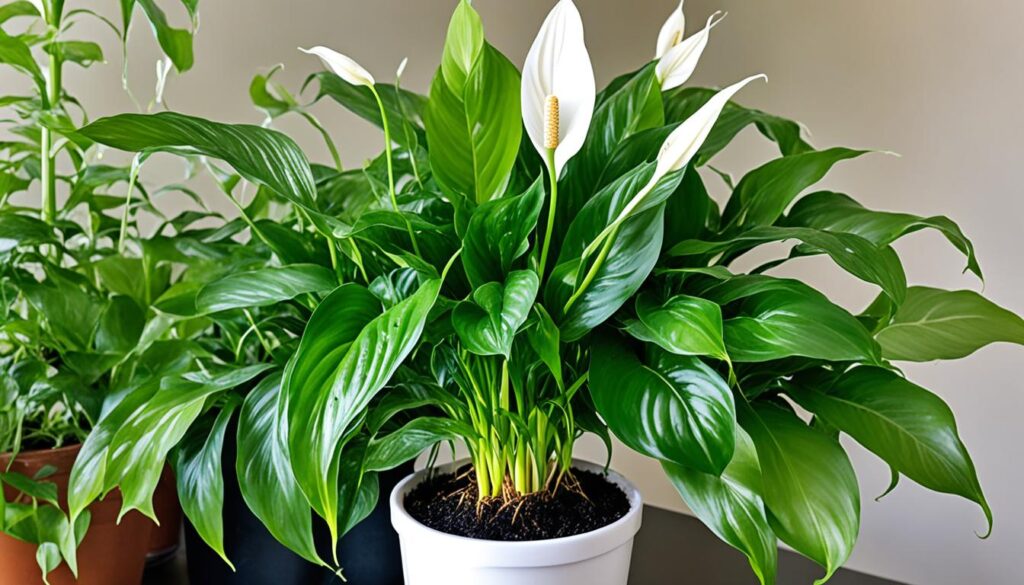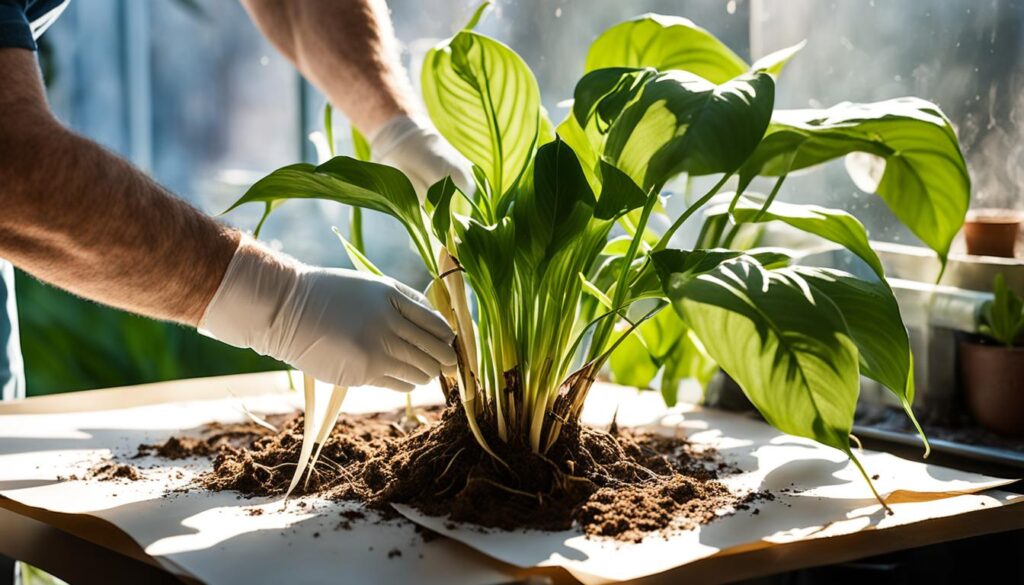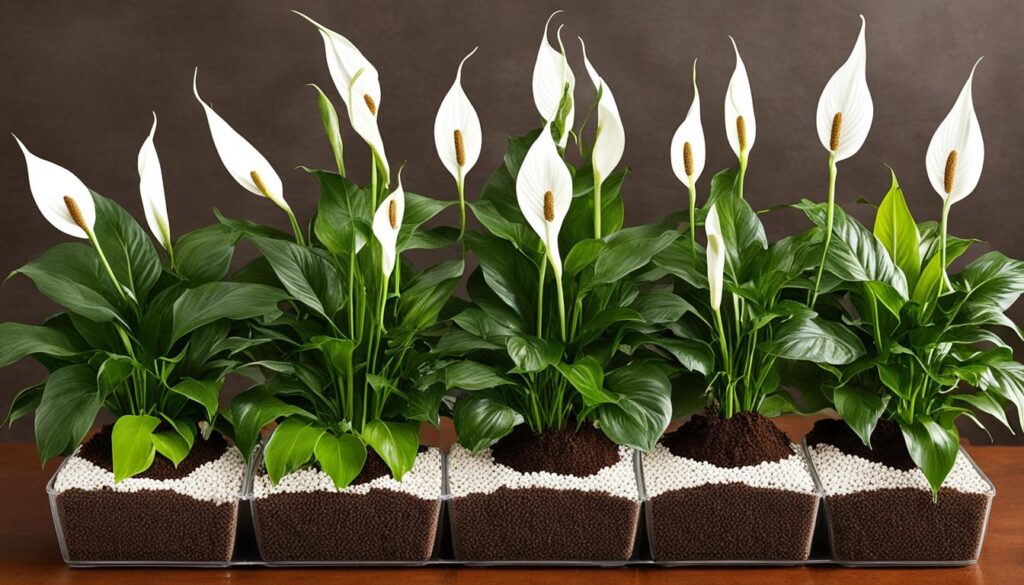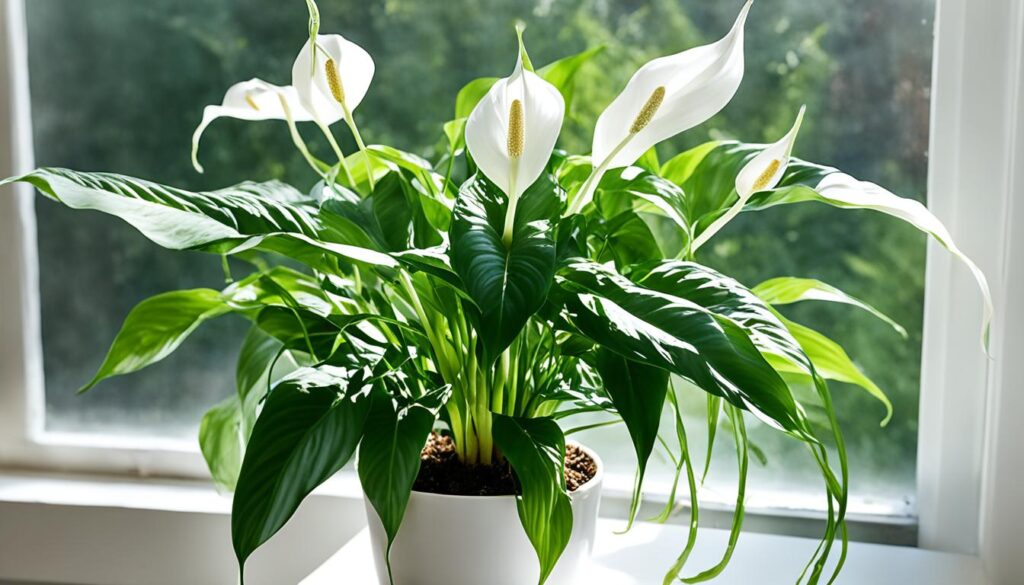Caring for a peace lily is rewarding for plant lovers. These plants are known for purifying the air and adding beauty indoors. They need proper repotting at the right time to thrive.
The Smith family loves their peace lily, named “Lily.” It brings calm and color to their home. When Lily’s leaves drooped and growth slowed, it was time to repot.
Repotting a peace lily is key for its health. It gets fresh nutrients, encourages growth, and prevents root problems. Knowing when to repot a peace lily helps keep your garden thriving.
Key Takeaways
- Repotting a peace lily is crucial for its growth and health.
- The recommended time to repot is every 1-2 years, during the plant’s active growth phase.
- Signs that a peace lily needs repotting include stunted growth, roots visible on the soil surface, and soil that dries out quickly.
- Selecting the right pot size and using a well-draining potting mix is essential for successful repotting.
- Proper post-repotting care, such as monitoring for transplant shock and maintaining optimal watering, is crucial for the plant’s recovery.
Introduction to Repotting Peace Lilies
Repotting a peace lily is key to its care. It lets the plant grow and thrive. You give it a bigger pot, fresh soil, and better root health. This way, the peace lily can produce lots of leaves and beautiful flowers.
Importance of Repotting for Plant Growth and Health
If you don’t repot a peace lily, it may not grow well. It might lack nutrients and have other problems. By repotting, you make sure the peace lily gets what it needs to be healthy and beautiful.
“Repotting a peace lily is essential for its long-term health and vibrant appearance.”
Peace lilies should be repotted every 1-2 years, usually in spring. A bigger pot and fresh soil help the plant grow well. This leads to lots of green leaves and beautiful white flowers.
Signs that a Peace Lily Needs Repotting
Peace lilies grow and can become rootbound, showing it’s time for a new pot. Look for signs that your peace lily needs a bigger home:
Roots Growing Out of the Pot
When roots grow out of the pot or show on the soil surface, it’s a clear sign. This means the plant has outgrown its space and needs more room to flourish.
Soil Drying Out Quickly
Soil drying out fast, even after watering, suggests your peace lily needs repotting. Rootbound plants can’t hold moisture well, leading to dry soil quickly.
Stunted Growth or Lack of Blooms
Rootbound peace lilies may grow slowly or not bloom much. They focus on keeping their leaves rather than growing or flowering. Repotting can help them grow and bloom better.
Watch for these peace lily repotting signs to keep your plant healthy. Fixing rootbound peace lilies and other peace lily growth issues with timely repotting is key for your indoor garden’s success.

“Repotting peace lilies is essential for their continued growth and vitality. It’s a simple task that can make a big difference in the plant’s overall health and appearance.”
Best Time to Repot a Peace Lily
Repotting a peace lily is best done in the spring or early summer. This matches the plant’s active growth cycle. It helps the plant adjust to new soil and grow well. Avoid repotting in winter, as it can stress the plant and slow its recovery.
Experts say the best time to repot a peace lily is in spring or early summer. Repotting during active growth gives your peace lily a chance to thrive. Look for signs like discoloration, wilting, or exposed roots to know when it needs repotting.
If a peace lily is severely rootbound, you should repot it right away. Choose a pot that’s only 1 or 2 inches (2.5-5 cm.) larger than the current one. This helps prevent overwatering and promotes healthy growth.
Water the peace lily an hour or two before repotting to reduce shock. This makes the transition smoother. After, keep the top of the root ball just below the pot’s rim. Place the plant in a shady spot for a few days to help it settle.
Knowing the peace lily growth cycle and when to repot helps your plant flourish. This way, it keeps providing clean air for years.
Preparing for Repotting: Tools and Materials Needed
Before you start repotting your peace lily, make sure you have everything you need. You’ll need a new peace lily pot that’s a bit bigger than the one it’s in now. Also, get a good potting mix that drains well for indoor or tropical plants. Don’t forget gardening gloves and pruning shears.
Selecting the Right Pot Size
When picking a new pot, make sure it has drainage holes to stop water from pooling. The peace lily pot size should be about 2 inches bigger in diameter than the old pot. This helps avoid making the pot too big.
Choosing a Well-Draining Potting Mix
The peace lily soil requirements call for a mix that drains well. This mix should have things like perlite or vermiculite to help with air flow and drainage. A good mix for peace lilies is 3 parts perlite, 3 parts orchid bark chunks, 3 parts coconut coir, and 1 part worm castings.

“Repotting a peace lily is recommended every two to three years, with more frequent repotting if the plant receives plenty of sunlight.”
Step-by-Step Guide to Repotting a Peace Lily
Repotting a peace lily is a careful process. It ensures the plant stays healthy and grows well. Start by gently removing the plant from its pot. You can do this by tipping the pot sideways or using a butter knife to loosen the soil.
Inspecting and Pruning the Roots
After removing the plant, check the roots closely. Look for any damage or rot. Use clean, sharp scissors or pruning shears to cut out any unhealthy parts. This is key for the peace lily root care and overall health.
Positioning the Plant in the New Pot
Put a layer of fresh potting mix in the new pot. Then, place the peace lily at the same depth as before. Fill the rest with potting mix and press it down gently to remove air pockets. This peace lily repotting process makes sure the plant fits well in its new home.
“Repotting a peace lily is an essential part of maintaining its health and promoting its growth. By following these steps, you can ensure your plant thrives for years to come.”
The best time to repot a peace lily is in the spring or early summer. At this time, the plant is actively growing. With the right how to repot a peace lily steps, your plant will grow healthy and vibrant.
Caring for a Repotted Peace Lily
After repotting your peace lily, it’s important to care for it well. This helps the plant adjust to its new home. Keeping the right watering and humidity levels is crucial for peace lily care after repotting.
Watering and Humidity Requirements
Water the peace lily well, making sure the soil is moist but not too wet. Check the soil often and water when it feels dry on top. It’s important to keep the humidity around the plant at 50-60%. You can do this with a pebble tray or a humidifier.
Don’t put the plant in direct sunlight or extreme temperatures. These can stress the peace lily water and humidity needs even more after repotting. Let the plant settle in before adding more stress.

“Consistency in moisture and temperature is essential in preventing droopiness in peace lilies.”
With the right care, your repotted peace lily will recover and flourish. It will give you beautiful flowers and lush leaves for many years.
When to Repot a Peace Lily?
Periodically repotting your peace lily is key to its health and growth. Aim to repot every 1-2 years or when it needs more space or fresh soil. Spring or early summer is the best time to do this, when the plant is growing well. This helps the plant bounce back from repotting stress and keeps it thriving.
If your peace lily looks unhealthy or seems rootbound, like stunted growth or droopy leaves, repot it quickly, no matter the season. Taking action fast can help it get better and stop further decline.
Knowing the peace lily growth cycle helps you know when to repot. They grow a lot in spring and summer. So, it’s a good time to give them fresh soil and a bigger pot for their roots.
“Repotting a peace lily at the right time can make a significant difference in its overall health and performance.”
Pay attention to your peace lily’s needs and repot during the best seasons. This way, your plant will keep doing well and add beautiful white flowers to your home.
Dividing or Splitting an Overgrown Peace Lily
If your peace lily has grown too big for its pot, you can either repot it or split it. Splitting the plant is great if you want smaller plants or if the pot is too full. This method, called peace lily propagation, lets you share plants or grow more of them.
To split a peace lily, carefully separate the roots into two or more parts. Make sure each part has healthy roots and some leaves. You can do this anytime, but spring or early summer is best.
“Peace lilies are best propagated by division, splitting existing plants into two or more sections and replanting them.”
When splitting a peace lily, be gentle to avoid stressing the plant. Take the plant out of its pot and use a clean knife or pruners to cut the roots. Each piece should have roots and leaves to grow well.

After splitting, put each piece in a pot with good drainage and water well. This helps the roots settle and promotes new growth. With the right care, your split peace lilies will do great. You can share them with friends or grow more for yourself.
Troubleshooting Transplant Shock
Repotting a peace lily can be tricky, and it often leads to transplant shock. This shock can show as wilting leaves, yellowing leaves, or slow growth. But, with the right steps, you can lower the risk of shock and help your peace lily adjust well.
Preparing for a Smooth Transition
Getting your peace lily ready for repotting is crucial. Make sure to water it well before moving it to a new pot. This helps prevent dehydration during the move. Also, pick a pot that’s only a bit bigger than the old one, and use a good potting mix that drains well.
When taking the peace lily out of its old pot, be gentle with the roots. Check for any rot or crowding and trim if needed. Then, put the plant in its new pot, making sure the soil level is the same as before.
Providing Post-Repotting Care
After moving your peace lily, give it special care. Put it in a spot with soft, indirect light and keep it away from direct sunlight. Stick to a regular watering schedule, keeping the soil moist but not too wet. Also, start giving it a slow-release fertilizer to help it recover and grow.
With patience and proper care, your peace lily should get over transplant shock in a few weeks. By following these steps, you can ease the stress and make the move easier for your plant.
“The key to a successful peace lily repotting is minimizing stress and providing the plant with the right conditions to thrive in its new home.”
Ideal Soil Mix for Peace Lilies
Choosing the right potting mix is key for peace lilies to grow well. These plants need soil that drains well and has lots of nutrients. It should also keep some moisture but not get too wet.
The ideal potting mix for peace lilies is a mix of peat moss, perlite, and sand. Peat moss keeps the soil moist. Perlite and sand help with air flow and stop water from pooling. This mix gives peace lilies the right amount of moisture and drainage.
Ingredients for a Well-Draining Potting Mix
- Peat moss: Retains moisture and improves soil structure.
- Perlite: Enhances aeration and drainage in the soil.
- Sand: Adds weight and further improves drainage.
When you’re repotting a peace lily, use a top-notch potting mix made for indoor or tropical plants. Then, add more perlite or sand if needed to get the soil just right.
“A well-draining, nutrient-rich potting mix is essential for the long-term health and growth of peace lilies.”

Give your peace lily the right soil mix, and it will flourish. You’ll see beautiful leaves and flowers. Just keep an eye on the soil moisture and water it right to keep your peace lily happy.
Repotting Rootbound Peace Lilies
If your peace lily is severely rootbound, with roots out of the drainage holes or on the soil surface, it needs repotting. Plants like this struggle to get water and nutrients, causing stunted growth and health issues.
When you repot a rootbound peace lily, be gentle with the roots. Loosen and untangle them carefully to avoid damage. Use a dull knife or massage the root ball to separate the roots. A bigger pot with fresh, well-draining soil can help your peace lily grow well.
Signs of a rootbound peace lily include:
- Roots growing out of the drainage holes or covering the soil surface
- Soil drying out quickly, even when watered regularly
- Stunted growth or lack of blooms
Fixing the rootbound issue and repotting your peace lily can make it thrive. Choose a pot that’s 2-5 cm bigger than the old one. Use a high-quality, well-draining potting mix for the best growth.
Repotting a rootbound peace lily might not solve the problem forever. The plant’s needs will keep growing. It’s key to repot your peace lily every 1-2 years to keep it healthy and bright.
Pot Size Considerations for Peace Lilies
Choosing the right pot size is key for healthy peace lilies. These plants do well when their roots are a bit cramped. So, pick a pot that’s only 2-5 cm (1-2 inches) bigger than the last one.
A pot that’s too big can make the soil too wet, causing root rot. A pot that’s too small will slow down the plant’s growth and make the soil dry out fast. It’s better to increase the pot size slowly as the plant grows.
Experts suggest starting with a pot about 10 cm (4 inches) wide for young peace lilies. When it’s time to move up, add 5 cm (2 inches) to the pot size each time. Avoid using pots over 25 cm (10 inches) to prevent root rot and make moving the plant easier.
It’s a good idea to repot peace lilies every 1-2 years, usually in the spring or early summer. This is when they grow the most. By following these peace lily pot size tips, you’ll help your plant grow strong and healthy.

“Timing repotting in the spring or early summer during the active growth phase is deemed the best practice.”
Post-Repotting Care and Maintenance
After repotting a peace lily, it’s important to care for it well. Start by watering it well, but don’t overdo it. The new soil might hold moisture differently than before.
Put the peace lily in a spot with bright, indirect light. Avoid direct sunlight, as it can stress the plant. Watch for signs of shock, like wilting or yellow leaves, and adjust care as needed.
- Wait 2-4 weeks before resuming fertilizer application to allow the plant to recover.
- Increase humidity around the peace lily by placing it on a tray of pebbles to aid in its recovery.
- Inspect the plant for pests and address any issues before transplanting.
With proper care, the peace lily should bounce back and grow well. Keeping peace lilies healthy after repotting is key for their success and blooms.
“Proper post-repotting care is the key to helping a peace lily thrive in its new environment.”
Follow these tips for peace lily care after repotting. This way, your plant will recover fast and keep adding beauty to your space.
Conclusion
Repotting a peace lily is key to its care. It helps the plant grow and stay healthy. Look for signs like roots coming out of the pot or soil drying fast. This tells you it’s time to repot.
When you need to repot, pick a pot that’s the right size and use a mix that drains well. Do this during the spring or early summer when the plant is growing. After repotting, keep up with good care to help the peace lily adjust. This way, your peace lily will give you beautiful leaves and flowers for many years.
By knowing when to repot a peace lily and giving it the right care, your plant will flourish. It will keep making your home look beautiful and peaceful. With the right care, your peace lily will be a beautiful, easy-to-care-for addition to your home.



Thank you for your sharing. I am worried that I lack creative ideas. It is your article that makes me full of hope. Thank you. But, I have a question, can you help me?